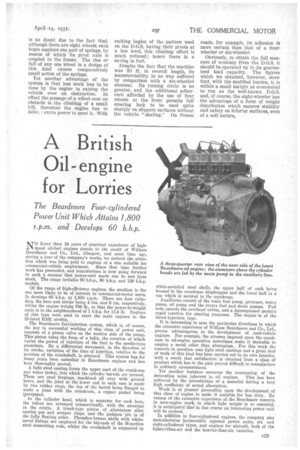A British Oil-engine for Lorries
Page 51

If you've noticed an error in this article please click here to report it so we can fix it.
The Beardmore Fourcylindered Power Unit Which Attains 1,800 r.p.m. and Develops 60 b.h.p.
NTO fewer than 10 years of practical experience of high..1.•4 speed oil-fuel engines stands to the credit of William Beardmore and Co., Ltd., Glasgow, and some time ago,• during a tour of the company's works, we noticed the attention which was being paid to engines of a size suitable for commercial-vehicle employment. Since that time further work has proceeded, and manufacture is now going forward in such a manner that power-unit needs can be met from stock. The range includes 60 b.h.p., 90 b.h.p. and 120 b.h.p. models.
Of the range of high-efficiency engines, the smallest is the one most likely to be of interest to commercial-motor users. It develops 60 b.h.p. at 1,800 r.p.m. There are four cylinders, the bore and stroke being 4 ins. and 6 ins, respectively, whilst the engine weigh e 700 lb., so that the power-to-weight ratio is in the neighbourhood of 1 b.h.p. for 11.6 lb. Engines of this type were used to start the main engines in the ill-fated R101 airship.
The Beardmore fuel-injection system, which is, of course, the key to successful working of this class of power unit, consists of a piston valve on the suction side of the pump. This piston takes the form of a helix, the rotation of which varies the period of injection of the fuel to the needle-typo atomizers. By a differential movement, in the direction of its stroke, variation of the time of injection, relative to the position of the crankshaft, is attained. This system has for many years been embodied in Beardmore engines and has been thoroughly proved.
A light steel casting forms the upper part of the crankcase and water jacket, into which the cylinder barrels are pressed. These are steel forgings, machined all over with ground bores, and the joint at the lower end in each case is made by two rubber rings, the top of the barrel being .flanged to make a joint with the crankcase, a copper gasket being interposed, In the cylinder head, which is separate for each bore, the valves are arranged symmetrically, with the atomizer in the centre. A trunk-type piston of _aluminium alloy carrieS gas and scraper rings, and the gudgeon' pin is of the fully floating order. Phosphor-bronze shells with whitemetal linings are employed for the big-ends of the II-section steel connecting rods, whilst the crankshaft is supported in white-metalled steel shells, the upper half of each being housed in the crankcase diaphragms and the lower half in a cap which is secured to the crankcase.
Auxiliaries consist of the main fuel pump, governor, water pump, oil pump and the rotary fuel and drain pumps. Pull rods operate the overhead valves, and a decornpressor permits rapid rotation for starting purposes. The engine is of the direct-injection type.
It is interesting to note the particular directions in which the extensive experience of William Beardmore and Co., Ltd., proves advantageous in the development of road-vehicle engines. For example, the stresses imposed upon the crankcase in oil-engine operation sometimes make it desirable to employ a metal other than aluminium.. For this work thm concern in question uses light steel castings and a great deal of work of this kind has been carried out in its own foundry, with a result that satisfaction is obtained from a class of product which has in the past proved difficult to manufacture in ordinary circumstances.
Yet another instance concerns the overcoming of the detonation noise inherent in oil engines. This has been achieved by the introduction of a material having a very high coefficient of sound absorption.
Work is at present proceeding upon the development of thisclass of engine to make' it suitable for bus duty. ty reason of the extensive experience of the Beardnioie concern, in aero-engine work,in which light weight is so essential, it is anticipated that in due course an interesting power unit will be evolved.
In addition to four-cylindered engines, the company aLso manufactures horizontally opposed Power units, six . nnd eight-cylindered types, and engines' for aircraft, both of the lighter-than-air and the heavier-than-air varieties.












































































































